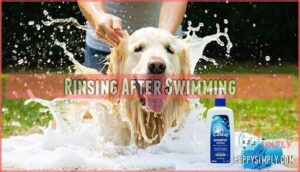This site is supported by our readers. We may earn a commission, at no cost to you, if you purchase through links.
 Swimming for dogs is a pawsome way to keep your furry friend healthy and happy.
Swimming for dogs is a pawsome way to keep your furry friend healthy and happy.
It’s low-impact, making it perfect for dogs with arthritis, hip dysplasia, or injuries. Plus, it builds endurance and helps with weight management.
Some pups love splashing through outdoor lakes, while others prefer cozy indoor pools with heated water. Denver even has dog-friendly beaches for your adventure-loving pooch.
To stay safe, always use a doggy life vest in deep water, rinse off after swims, and limit time in the water. Want to turn your pup into a confident swimmer? Treats, toys, and a bit of patience work wonders! It’s a great way to keep your dog happy.
Table Of Contents
- Key Takeaways
- Benefits of Dog Swimming
- Popular Swimming Locations
- Safety Tips for Dogs
- Introducing Dogs to Swimming
- Swimming Facilities and Services
- Frequently Asked Questions (FAQs)
- Is swimming good for your dog?
- Is it OK for my dog to swim?
- How much swimming should a dog do?
- Is it better for dogs to walk or swim?
- What is the best type of life jacket for dogs who swim?
- How often should a dog swim for optimal health?
- Is swimming more beneficial for certain breeds of dogs?
- Are there any health risks associated with swimming for dogs?
- Are there any swimming classes available for dogs?
- How do I choose the best swimming facility?
- Conclusion
Key Takeaways
- Swimming’s great for your dog’s health—it strengthens muscles, improves joints, and helps with weight management.
- Always prioritize safety with dog life vests, supervised sessions, and rinsing off after swims to prevent infections.
- Denver offers amazing spots for dog swimming, like Cherry Creek State Park, heated pools, and dog-friendly beaches.
- Start slow with shallow water, use treats and toys for encouragement, and keep swim sessions fun and positive.
Benefits of Dog Swimming
Swimming gives your dog a full-body workout that’s easy on their joints. It’s a fun way to boost their health, build endurance, and even aid recovery from injuries.
Improves Canine Health
Swimming is fantastic for your dog’s health.
Swimming is a full-body, joint-friendly workout that boosts your dog’s health, builds stamina, and keeps their tail wagging!
It supports joint health, builds muscle strength, and aids in weight management. Plus, it boosts cardiovascular health and mental well-being.
Here’s why canine swimming works:
- Low-impact on joints, so it’s gentle.
- Strengthens muscles without stress.
- Burns calories for weight control.
- Keeps their hearts strong and healthy, which is essential for their overall well-being.
Enhances Dog Rehabilitation
Water therapy does wonders for injury recovery and canine rehabilitation.
Hydrotherapy benefits include easing arthritis pain, improving mobility, and muscle strengthening.
Hydrotherapy soothes arthritis, enhances mobility, and strengthens muscles—offering a gentle, low-impact path to happier, healthier tails.
Post-surgery swimming helps dogs regain strength gently, thanks to water’s low-impact properties.
It’s like a spa day for your pup, from injury recovery to arthritis relief, hydrotherapy for dogs is a soothing path toward better health and wagging tails.
Increases Dog Endurance
Endurance training is a game-changer for active pups. Dog swimming builds stamina while offering low-impact exercise.
It’s perfect for dogs recovering from injuries or staying fit.
- Boosts overall stamina for energetic play.
- Ideal for active recovery after intense activities.
- Strengthens muscles through water exercise.
- Provides aerobic workouts in a safe environment.
- Encourages balanced canine exercise with less strain.
Popular Swimming Locations
Finding the perfect spot for your pup to swim is easier than you’d think near Denver.
From indoor pools with year-round access to scenic outdoor parks and beaches, there’s something for every dog and their adventure-loving owner.
Indoor Dog Swimming Facilities
Diving into a clean, heated indoor pool is a great way for your dog to stay active year-round.
With options like filtered or saltwater pools, you’ll find facilities like CRCG or Hobnob Pet offering private swims suited to specific breeds.
Pool sanitation and staff supervision guarantee safety, while some venues even let you join the fun!
Outdoor Swimming Spots
Denver’s outdoor gems offer tail-wagging dog-friendly locations for a splash.
From scenic trails to serene waters, these spots are a paw-fect escape.
- Cherry Creek State Park: Off-leash area with seasonal access.
- Chatfield State Park: Wide ponds for dog swimming.
- Westminster Hills Park: 420 acres and a pond!
- Union Reservoir: Algae-free, dog-approved zones.
- Coot Lake: A serene dogfriendly lake getaway.
Dog Beaches Near Denver
Heading to outdoor spots? Dog beaches near Denver are perfect for a swim.
At Cherry Creek or Chatfield State Park, you’ll find seasonal access and water fun. Coot Lake offers quiet beaches, ideal for good swimmers.
Always check algae concerns, follow beach regulations, and supervise your pup. Beach etiquette keeps everyone happy.
Grab towels and go to enjoy the water fun!
Safety Tips for Dogs
Keeping your dog safe while swimming is easy with a few simple precautions.
From watching for algae to setting time limits, these tips help keep your pup happy and healthy in the water.
Fresh Water Precautions
Freshwater swimming sounds fun, but staying safe takes effort.
Keep an eye on water quality to avoid toxic algae blooms. Parasite prevention is a must—ask your vet about the best options.
After a swim, dry those doggy ears to help prevent infections.
Rinsing After Swimming
After your dog’s swim, rinse them thoroughly to wash off chlorine, salt, or algae.
Use gentle shampoo options to protect their skin and prevent hotspots. To help maintain their coat’s health, consider using a gentle dog shampoo.
Drying techniques matter—focus on ears to avoid infections. Ear cleaning is key for dog health, especially for floppy-eared breeds.
Routine rinses keep their coat shiny and maintain overall pet care, ensuring happy splashes ahead!
Time Limits for Swimming
Not all dogs are natural swimmers, so tailor swim session length to their breed, age, and stamina.
Puppies and older dogs may tire quickly, so watch for fatigue signs like slowing down or struggling.
Start with short sessions and gradually increase time as they build endurance.
Safe, enjoyable dog aquatic exercise comes with patience and attention to dog swimming limits and safety.
Introducing Dogs to Swimming
Getting your dog comfortable in the water can be a fun and rewarding experience. Start slow, use treats, and keep it positive to help them build confidence while splashing around.
Starting in Shallow Water
When introducing dog swimming, start with a gradual introduction in shallow water.
Use leash guidance for control while fostering confidence.
If they hesitate, try a dog life vest for reassurance.
Your calm demeanor and steady encouragement build trust.
Keep it relaxed and fun; shallow entry helps dogs feel secure.
Early positive reinforcement guarantees dog swim lessons are enjoyable and safe.
Rewards and Encouragement
Building confidence during dog swim lessons works best with positive reinforcement. Combine verbal praise, treat motivation, and toy rewards to celebrate small wins.
Cheer enthusiastically when they paddle or stay calm in the water. These moments boost confidence and make swimming fun.
Remember, patience goes a long way in dog swim training. Turn every splash into a step forward with small wins.
Luring With Rewards
Treats and toys work wonders for timid swimmers.
Use toy motivation or tasty treats to coax your pup into the water, making dog swimming lessons fun.
Pair lures with verbal praise or clicker training for extra encouragement.
Positive reinforcement keeps them excited.
For the best results, choose rewards they love—after all, dog swim training should feel like play, not work!
Many owners find specialized floating treats helpful for this purpose, using positive reinforcement and tasty treats.
Swimming Facilities and Services
You’ll find plenty of facilities near Denver offering year-round swimming for your dog.
From heated pools to life vests and expert supervision, these services guarantee safety and fun for pups of all ages.
Heated Pool Services
Heated pools are a game-changer for your dog’s swimming routine.
With warm water, high-quality filtration, and indoor advantages, they’re perfect for year-round fun or hydrotherapy benefits like easing joint pain.
Indoor pools keep things comfortable regardless of the weather while post-swim care like towels and dryers guarantees your pup stays happy and healthy.
It’s canine recreational swimming made easy, providing year-round fun for your dog.
Doggy Life Vests and Supervision
Dog swimming facilities make safety a top priority.
Staff training focuses on supervised play and emergency procedures.
Doggy lifevests, with proper vest sizing and buoyancy ratings, guarantee comfort and water safety.
You can find various dog life vests online.
Lifeguards are always present to assist first-timers and nervous pups.
Watching your dog paddle confidently with the right gear is as reassuring as knowing they’re in expert hands.
Pricing and Package Deals
Dog swimming pricing varies to match your pup’s needs.
Check these options:
- Single swim sessions ($18-$65) for a quick splash.
- Membership savings up to $600 annually.
- Package comparisons: Save with 5/10-session deals ($132.5+).
- Training discounts for swim lessons or therapy ($40/session).
- Add-on services like towels or baths ($12).
Find what suits your buddy best, with membership savings and package comparisons to help you decide, and consider add-on services for extra convenience.
Frequently Asked Questions (FAQs)
Is swimming good for your dog?
Swimming’s fantastic for dogs! It boosts joint health, builds stamina, and burns energy without stressing their bodies.
Plus, it’s fun!
Just make certain your pup’s comfortable in water, supervised, and swimming in safe, clean spots.
Is it OK for my dog to swim?
Think of swimming as your dog’s ultimate playground—it’s great for exercise, joints, and mental stimulation.
Most dogs can swim safely, but always supervise, check water quality, and consider your dog’s health and comfort first.
How much swimming should a dog do?
A few short sessions a week are great for most dogs.
Start with 5-10 minutes, then gradually increase as they build stamina.
Pay attention to signs of fatigue—no one likes an over-tired pup!
Is it better for dogs to walk or swim?
It depends on your dog’s health and preferences.
Walking is great for everyday exercise and bonding, while swimming builds strength and is low-impact.
Both are beneficial, so mix them up based on your dog’s needs, with swimming being a great option for low-impact exercise.
What is the best type of life jacket for dogs who swim?
Better safe than sorry" applies here—look for a life jacket with a sturdy handle, adjustable straps, and bright colors.
Verify it fits snugly but isn’t tight.
A reflective trim adds extra safety for adventures.
How often should a dog swim for optimal health?
For ideal health, let your dog swim 2–3 times a week.
It’s great cardio, builds muscles, and eases joint pain.
Start slow, watch their stamina, and always make it fun and safe!
Is swimming more beneficial for certain breeds of dogs?
Swimming suits breeds like Labradors, Retrievers, and Poodles better, thanks to their natural affinity for water and webbed feet.
However, dogs that aren’t naturally inclined can still benefit with proper training, patience, and encouragement.
Are there any health risks associated with swimming for dogs?
Dogs can face ear infections, fatigue, or injuries from swimming.
Watch for toxic algae or strong currents in natural waters.
Always rinse them after, dry their ears, and keep swim sessions fun but safe!
Are there any swimming classes available for dogs?
Ever feel like your dog’s potential is untapped?
Personalized swimming classes like the Learn to Swim package help dogs gain confidence in water.
CRCG, K9 Body Shop, and others offer enjoyable sessions customized to your pup!
How do I choose the best swimming facility?
Pick a facility based on your dog’s needs—rehab, fun, or training.
Check reviews, pool safety (like heated water and supervision), and services like life vests.
Proximity and appointment policies matter too.
Conclusion
A happy dog is a healthy dog, and swimming for dogs is a perfect way to keep tails wagging!
Whether you’re boosting your pup’s fitness, aiding recovery, or just having fun, swimming offers endless benefits.
Denver has plenty of spots—from heated pools to dog-friendly beaches—making it easy to plunge into adventure.
Remember, safety comes first with life vests and rinsing off after swims.
With treats, patience, and love, your dog’s inner swimmer will shine!














